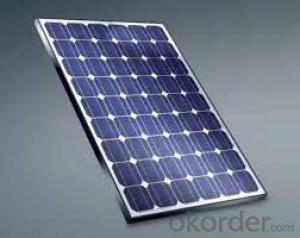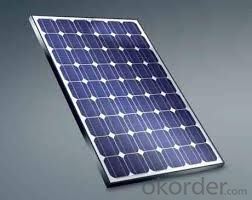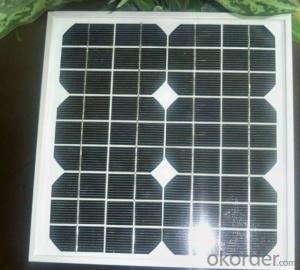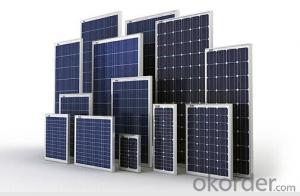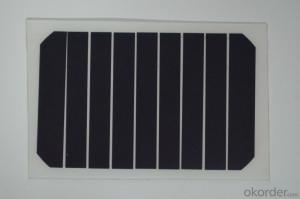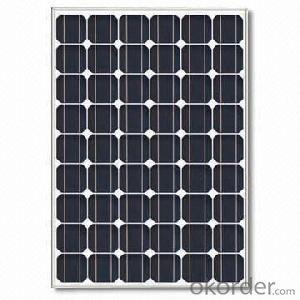Small 12W Monocrystalline Solar Panel CNBM
- Loading Port:
- Qingdao
- Payment Terms:
- TT OR LC
- Min Order Qty:
- 10 set
- Supply Capability:
- 300000 set/month
OKorder Service Pledge
OKorder Financial Service
You Might Also Like
Small Monocrystalline Solar Panel with 12W
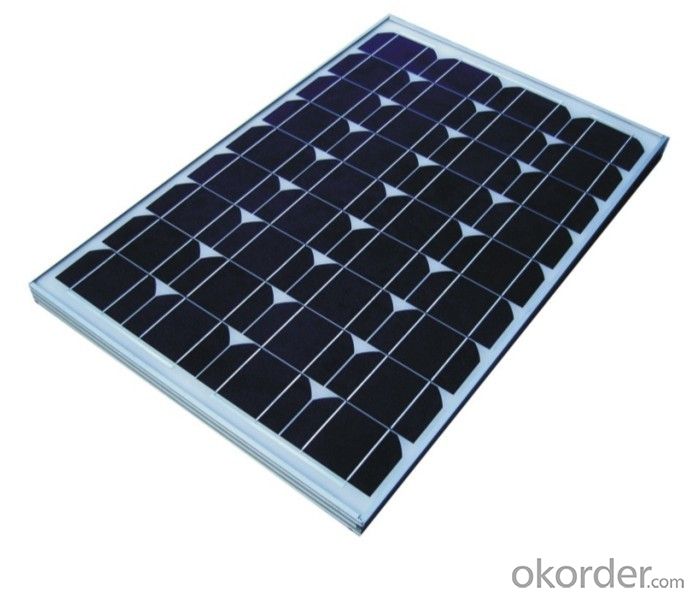
Monocrystalline Solar Modules
We offers a range of small, medium and large monocrystalline solar modules, designed for a range of requirements.
Specifications:
Tolerance | +/- 3% |
Cell | Monocrystalline silicon solar cells |
N0. of Cells | 72 (12 x 6) |
Dimension of Modules (mm) | 1581 x 809 x 40 |
Weight (kg) | 15.5 |
Limits:
Operating Temperature | -40~+85? |
Storage Temperature | -40~+85? |
Maximum System Voltage | 1000 VDC max. |
Hail Impact | Diameter of 28mm with impact speed of 86km/h |
Temperature and Coefficients:
NOCT | 48C+/-2? |
Voltage temperature coefficient (%/K) | -0.34 |
Current temperature coefficient (%/K) | 0.09 |
Power temperature coefficient (%/K) | -0.37 |
Characteristics:
Model: | SGM-160D | SGM-165D | SGM-170D |
Max-power voltage Vmp (V) | 34.5 | 35.4 | 35.8 |
Max-power current Imp (A) | 4.64 | 4.66 | 4.75 |
Open-circuit voltage Voc (V) | 41.75 | 43.6 | 43.32 |
Short-Circuit Current Isc (A) | 5.32 | 5.08 | 5.38 |
Max-power Pm(W) | 160 | 165 | 170 |
Model: | SGM-175D | SGM-180D | SGM-185D |
Max-power voltage Vmp (V) | 36.1 | 36.2 | 36.2 |
Max-power current Imp (A) | 4.85 | 4.97 | 5.11 |
Open-circuit voltage Voc (V) | 43.68 | 43.8 | 44.8 |
Short-Circuit Current Isc (A) | 5.49 | 5.48 | 5.51 |
Max-power Pm(W) | 175 | 180 | 185 |
STC: Irradiance 1000W/m2, Module temperature 25?, AM=1.5
Monocrystalline Solar Panels Specifications Range
Maximum Power (Pm) | Dimension | Weight | Operating Voltage (Vmp) | Operating Current (Imp) | Open Circuit Voltage (Voc) | Short Circuit Current (Isc) |
3W | 158x241x25mm | 0.5kg | 8.5V | 0.36A | 10.5V | 0.4A |
4W | 308x166x25mm | 0.77kg | 8.5V | 0.47A | 10.5V | 0.54A |
4W | 308.x166x25mm | 0.77kg | 16.8V | 0.24A | 21V | 0.27A |
5W | 296x215x25mm | 0.3kg | 16.8V | 0.48a | 21V | 0.54A |
10W | 286x406x25mm | 1.5kg | 16.8V | 0.59A | 21V | 0.66A |
12W | 286x406x25mm | 1.5kg | 16.8V | 0.71A | 21V | 0.8A |
14W | 286x541x25mm | 2kg | 16.8V | 0.83A | 21V | 0.96A |
16W | 286x541x25mm | 2kg | 17.2V | 0.93A | 21.5V | 0.99A |
18W | 296x541x25mm | 2.4kg | 18.8V | 1.07A | 21V | 1.2A |
20W | 296x641x25mm | 2.4kg | 17.2V | 1.15A | 21.5V | 1.24A |
24W | 541x451x25mm | 3.15kg | 16.8V | 1.14A | 21V | 1.56A |
26W | 541x451x25mm | 3.15kg | 17.2V | 1.51A | 21.5V | 1.63A |
30W | 296x966x25mm | 3.85kg | 16.8V | 1.78A | 21V | 2.03A |
36W | 541x641x35mm | 4.7kg | 16.8V | 2.14a | 21V | 2.4A |
40W | 541x641x35mm | 4.7kg | 17.2V | 2.33A | 21.5V | 2.5A |
55W | 1057x457x35mm | 6.6kg | 17.6V | 3.12A | 21.6V | 3.3A |
70W | 546x1196x35mm | 8.5kg | 16.8V | 4.15A | 21V | 4.7A |
75W | 546x1196x35mm | 8.5kg | 17.2V | 4.36A | 21.5V | 4.8A |
80W | 546x1196x35mm | 8.5kg | 17.6V | 4.55A | 21.6V | 4.9A |
110W | 1066x811x40mm | 11.8kg | 17.6V | 6.25A | 21.6V | 6.6A |
150W | 1066x811x40mm | 14kg | 34.4V | 4.36A | 43.2V | 4.7A |
- Q: Can the solar panels available be coated with a material (to improve it's looks) and not alter it's efficiency?
- No. The only coatings I am aware of are those that reduce reflection so more light gets through the protective surface to the actual cells. Anything thing that affects appearance is going to be reflecting light back to the viewer and the photons of that light are not available for electricity or heat. If the appearance of the panels offends you, then they need to be concealed by a fence of panels around them that do not throw shadows on the panels.
- Q: I live in Sacramento, CA, and I need some solar panels for a project fo school. They don't have to be very big......just something that I can use as an example.Thanks!
- I did the same thing recently, if you'd really like some free ones then you need to look for those little solar powered lamps that people put in their yards, theyre about 0 inches tall and people sometimes line the paths through their yard with them. Maybe you can find a neighbor who doesn't want theirs anymore, or you could check local dumps for them. They each have a solar panel in the top, and they can be linked together to make more power. Alternatively, you can look on OKorder for a pack of broken solar cells, which still work fine but don't put out quite as much power as they did when they were new. However, they are very cheap. Hope this helps.
- Q: Why can't they put solar-panels on the blades and sides of the 300-500 foot tall turbines? Wouldn't this increase effeciency? Therefore, boosting pay-back time, profits, energy-output?
- Good to know someone is thinking and coming up with original ideas, so thanks for contributing... Put a large powerful solar collector on the end of the turbine too i.e. facing the sky! Far as I know, solar works on day-light (doesn't have to face the sun). So your idea is not to be put down. Metal blade turbines - are heavy - wooden windmills - heavy... so some added weight to the wind-turbine's paddles would be OK robably. Great if solar device not made of glass (so unbreakable). I think panels on the roof are old hat...
- Q: How can I know the right type of solar panel to choose for my small village house in Africa?
- The power output of a solar panel uses a formula to determine kilowatts produced per hour per square meter per day. This calculation is important because, if you plan to install a solar power system for your home, you will want to know how many solar panels will be needed. To calculate solar power requirements correctly, you need to gather the data that is needed for the calculation. First you have to find the average amount of solar radiation available for your area. You can use a solar radiation chart. This can range from a 4 to a 7 depending on the area you live in. Write the number down on a piece of paper and indicate it with the letters RA. Next is determine the amount of electricity that you use daily. Add the kilowatt-hours used per month from your utility bill. Multiply this number by ,000 to get the watt hours in a month. Divide the total by 30 for the amount of electricity you use daily. Write this number down and indicate it with the letters DE. Determine the percentage of your home that you want to power with the solar power system. Write this number down and indicate it with the letter P. Determine the system inefficiency factor for the solar power system. You should be able to find this on the brochure for the system or from the manufacturer's web site. Write this number down and indicate it by the letter I. Determine the power or yield that is required for your home. Use the equation P = I x (DE x P) / RA to find the power requirements in kWh. Divide the number from Step 5 by the peak wattage for a single solar panel to determine the number of panels you will need for your home. Goodluck! :)
- Q: about solar panel
- The answer depends upon the type of solar energy captured . Photovoltaic Solar Panels convert the energy into electricity. This electricity is ran throughout the building via wires. Thermal Solar Panels typically capture the energy in the form of heat. The hot water is circulated through the building in water pipes.
- Q: Can solar panels be installed on agricultural or farming operations?
- Yes, solar panels can be installed on agricultural or farming operations. In fact, they are increasingly being adopted in these settings to generate clean and renewable energy. Solar panels can be installed on rooftops of barns, sheds, or other structures, as well as on open fields or unused land. By harnessing solar energy, farmers can reduce their electricity costs, lower their carbon footprint, and contribute to a more sustainable farming practice. Additionally, solar panels can provide shading for livestock or crops, minimizing heat stress and improving overall farm productivity.
- Q: Can solar panels be used for heating a greenhouse?
- Yes, solar panels can be used for heating a greenhouse. Solar panels can generate electricity, which can then be used to power heaters or heat pumps inside the greenhouse to provide warmth. Additionally, solar panels can also be used to heat water, which can be circulated through pipes or radiators to provide radiant heat in the greenhouse.
- Q: Is there a small solar panel system that I can put in my bedroom window and charge my phone and run an alarm clock off of? Or one I can run a microwave off of?
- Yeah they have them to charge phones but to use a microwave you would have to use one to charge a 2 volt battery with them from there an inverter . You could probably get a system like that for around $50 or so off OKorder . Don't get me wrong solar panels do cost allot but for what you want it for just to run a microwave isn't going to cost you all that much . Just go to OKorder and look for solar phone charger and get an idea of what you want . Thumb up for Sam above me . People just think everything is expensive because they put no effort in there shopping .
- Q: Can solar panels be installed on mobile homes?
- Yes, solar panels can be installed on mobile homes. In fact, mobile homes can be great candidates for solar panel installations due to their smaller size and affordability. Additionally, solar panels can help mobile homeowners save on electricity bills and reduce their carbon footprint.
- Q: I can't figure out how to charge a Ni Cd (BD 8V Firestorm) battery directly with a solar panel so I've come up with an alternative which might or might not work. I thought I would connect an inverter (I found a nice 400W for $30) to my trucks battery and plug the BD Firestorm battery charger into the inverter. Then I was thinking I could use a 5W solar panel to trickle charge the truck battery and keep it connected after the Ni Cd is charged to ensure the truck battery is topped off. The truck would not be running during this process. Will this solution work? Is there a better solution?
- Two of those solar panels connected in series will easily charge a 8V battery. I would not even be concerned about over voltage the solar cells will have plenty of internal resistance.
Send your message to us
Small 12W Monocrystalline Solar Panel CNBM
- Loading Port:
- Qingdao
- Payment Terms:
- TT OR LC
- Min Order Qty:
- 10 set
- Supply Capability:
- 300000 set/month
OKorder Service Pledge
OKorder Financial Service
Similar products
Hot products
Hot Searches
Related keywords
